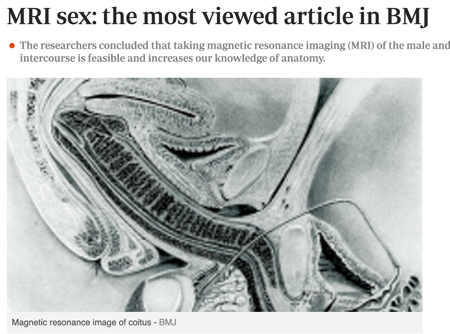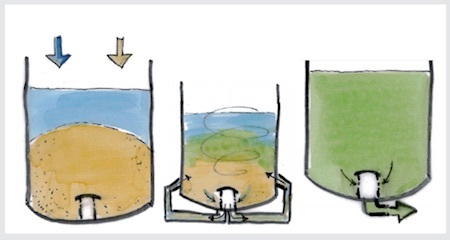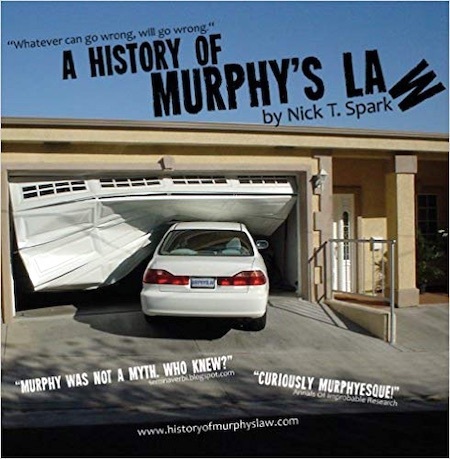Marc Abrahams's Blog, page 131
December 19, 2019
“MRI Sex: The most viewed article in BMJ”, still after 20 years
An editor of the British Medical Journal (The BMJ) told us a few years ago that one particular BMJ paper, published in 1999, has—from the moment that paper was awarded an Ig Nobel Prize in the year 2000— consistently drawn more web visitors—many, many more—than anything—anything—else published in the history of The BMJ. Everything every published in The BMJ, dating back to 1840; is accessible on the BMJ web site.
Th 20th anniversary of of that paper being published is being celebrated around the world, as well as in The BMJ itself:
This Christmas marks the 20th anniversary of the publication of “Magnetic resonance imaging of male and female genitals during coitus and female sexual arousal.” Why did it become one of the most downloaded BMJ articles of all time?
The Spanish newspaper ABC reports:
MRI Sex: The most viewed article in BMJ
This year marks the 20th anniversary of the publication of, possibly, the most downloaded scientific article in the British Medical Journal. “Magnetic resonance imaging of male and female genitals during intercourse and female sexual arousal,” it was titled…
Although in its first year the research picked up the Ig Nobel prize for medicine, at that time, nobody in “The BMJ” thought the study was particularly useful clinically or scientifically, but it contained “a striking image using a new technology, and everyone was I agree that readers might be interested in seeing it,” writes Tony Delamothe, former editor of the magazine.
Here’s another of the many reports, this one in the German newspaper Bild:
Ig Nobel Prizes and The BMJ
The Ig Nobel Prize for medicine, in the year 2000, was awarded to Willibrord Weijmar Schultz, Pek van Andel, Eduard Mooyaart, and Ida Sabelis, for their report, “Magnetic Resonance Imaging of Male and Female Genitals During Coitus and Female Sexual Arousal.”
Other studies published in The BMJ, too, have been honored with Ig Nobel Prizes. Navjoyt Ladher, The BMJ‘s clinical editor discussed this in an essay in December 2016, saying:
The [MRI sex] paper also has the honour of being the recipient of an Ig Nobel award. The prize is given each year by the Annals of Improbable Research for studies that are particularly unusual and imaginative. In her acceptance speech for the award, author and research participant Ida Sabelis described seeing the MRI images for the first time: “Not so much a passport photo for daily use but surely a shot that shows so much that it makes me speechless.”
Perhaps unsurprisingly, given the focus on quirky research questions, several other Christmas BMJ papers have also received the prize (box 1). These papers have examined the effect of different foods on the appetite of leeches, explored the occupational hazards of sword swallowing, and assessed the predictive value of abdominal pain in people with appendicitis when they go over speed bumps.
Since then, The BMJ has continued wracking up Ig Nobel wins, as you can discover (or re-discover) for yourself, by looking at the list of all Ig Nobel Prize winners.
Here’s a short documentary made ten years or so ago about the MRI sex study:

December 18, 2019
Ashley Edwards joins the Luxuriant Flowing Hair Club for Scientists (LFHCfS)
Ashley Edwards has joined the Luxuriant Flowing Hair Club for Scientists (LFHCfS). She says:
(LFHCfS). She says:
For a while, early in my career as a scientist, I watched Australian lungfish spawning. Then, for even longer, I watched blue tongued lizards having sex. Now I mostly tell undergrad students about it. All the while I have been ‘that lecturer with the really long blonde hair’. But I’ll have you know that blonde is more than just a hair colour—blonde is a State of Mind. ANYONE can be blonde!
Ashley Edwards, PhD., LFHCfS (and 2019 Ig Nobel physics prize winner, for studying how, and why, wombats make cube-shaped poo)
Senior lecturer
Bachelor of Science degree coordinator
Associate Head, Learning and Teaching
School of Natural Sciences
University of Tasmania
Hobart, Tasmania, Australia


The shape of a vibrated earthworm?
What shape does an earthworm take if someone vibrates the worm? Arnaud Hemmerle alerts us to an experimental attempt to find out.
Hemmerle says:
A few words about this wonderful paper, which tackles a deep and puzzling question: what is the shape of a vibrated earthworm?
Back in 2015, we published a paper entitled “Worm-like instability of a vibrated sessile drop“, in which we studied the shape of a vibrated liquid drop and a particular hydrodynamic instability. It turns out that the drop elongates for a certain range of frequencies and amplitudes, and takes a shape close to what an earthworm looks like. Until then, nothing very funny, I have to admit.
But it seems that Maksymov and Pototsky read our paper and thought: “Ok, fine, a vibrated drop may look like a worm … BUT WHAT ABOUT A REAL EARTHWORM???”
And it turns out that a vibrated earthworm (sedated first with ethanol, of course) shows some kind of sub-harmonic oscillations, similar in a way to what has been seen on vibrated liquid droplets.
The paper makes you laugh, and then think. They actually modeled the vibrated earthworm as an elastic cylinder, and the theoretical model seems to fit the observations. Oh and of course they have also built an earthworm mimicking phantom made of a finger of a latex glove filled with water. Because why not.
I do not know personally anyone involved in this paper, including the worms.
The study is: “Excitation of Faraday-like body waves in vibrated living earthworms,” Ivan S. Maksymov and Andrey Pototsky, bioRxiv 10.1101/868521, December 8, 2019. The authors, at Swinburne University of Technology, Australia, report:
Biological cells and many living organisms are mostly made of liquids and therefore, by analogy with liquid drops, they should exhibit a range of fundamental nonlinear phenomena such as the onset of standing surface waves. Here, we test four common species of earthworm to demonstrate that vertical vibration of living worms lying horizontally of a flat solid surface results in the onset of subharmonic Faraday-like body waves, which is possible because earthworms have a hydrostatic skeleton with a flexible skin and a liquid-filled body cavity. Our findings are supported by theoretical analysis based on a model of parametrically excited vibrations in liquid-filled elastic cylinders using material parameters of the worm’s body reported in the literature.

December 16, 2019
Face-taping for risk-takers [new study]
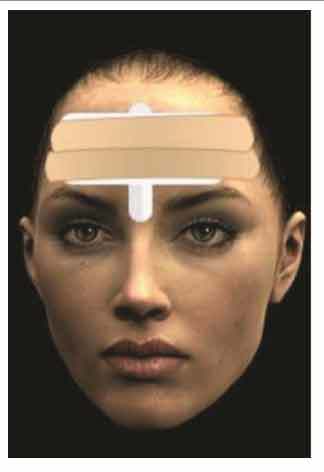 Does the anticipation of medical treatments, financial investments and leisure time activities sometimes make you anxious? Have you thought about taping your face up? A new research project from the Niedenthal Emotions Lab at the University of Wisconsin-Madison, US, investigated whether the nervous anticipation of a balloon-popping task and a jack-in-the-box spring* might to some extent be mitigated by the application of inflexible medical tape attached to the forehead to disrupt movement of the brow. (The participants also wore a mouth guard that interfered with actions involving the mouth.)
Does the anticipation of medical treatments, financial investments and leisure time activities sometimes make you anxious? Have you thought about taping your face up? A new research project from the Niedenthal Emotions Lab at the University of Wisconsin-Madison, US, investigated whether the nervous anticipation of a balloon-popping task and a jack-in-the-box spring* might to some extent be mitigated by the application of inflexible medical tape attached to the forehead to disrupt movement of the brow. (The participants also wore a mouth guard that interfered with actions involving the mouth.)
“The link that has been established between facial expression and emotional responding is sufficient to suggest that feelings of fear and anxiety are useful in determining the extent of risk to be accepted in a decision task. Given that fear and anxiety provide information about whether to accept or reject risk, the disruption of facial expressions of those feelings should promote greater risk taking than would be present in the absence of such disruption. Thus, the goal of the present research was to test the hypothesis that disrupting facial expressions associated with fear and anxiety leads to increases in risk-taking behavior.”
The findings – the reduction in nervous anticipation was associated with more risk-taking :
“The present findings across two studies demonstrate that restricting facial actions, and particularly brow and mouth actions associated with the anxiety or fear expression, leads to greater risk taking on two tasks in which action-related emotions are elicited. We conclude that facial expressions of emotions signal to the decision-maker that a risk should be avoided. When these facial responses are disrupted, however, the decision-maker feels freer to take the risk. Importantly, there was no effect on a decision task that did not require that the participant perform risk behaviors associated with action-related emotions.”
See: Carpenter, S. M., & Niedenthal, P. M. (2019). Disrupting facial action increases risk taking. Emotion. (Advance online publication). A full copy of which may be found here.
* Note re. the jack-in-the-box task: “ [..] being a children’s toy and not a controlled experimental task, [it] sometimes malfunctioned during the experiment (e.g., the lever would stick, the box would not close properly, etc.). Such malfunctions led to the loss of some data during the experiment and to somewhat weaker results.“
Research research by Martin Gardiner

December 13, 2019
The Unreliability of Our Rulers
We muse these days, many of us, on the unreliability of our rulers.
But that has been the state of things for quite a while now:
Complimentary small plastic rulers, being imprecise, inaccurate, flimsy and defaced with advertising, draw only a measured amount of respect from metrologists. In 1994, two metrologists took measures to see just how much respect the rulers deserve.
Metrologists are the people who come up with more accurate, more precise ways to measure things….

December 12, 2019
The Bavarian Pickle-Juice Experiment
The Bavarian Pickle-Juice Experiment is using salty waste-water from pickle-making to keep roads from becoming icy. Ig Nobel Prize winner Elisabeth Oberzaucher alerts us to this, with the comment “Waste from the food industry keeps roads ice-free – I’m curious to see what comes out during the testing phase.”
The publication Geo reports [in German, which we have machine-translated here into English] details, with the headline “Why the winter service in Bavaria now uses cucumber water instead of road salt“:
The company Develey Senf & Feinkost GmbH, based in Dingolfing in Lower Bavaria, processes 17,000 tonnes of cucumbers into gherkins every year. The cucumber water from the main plant, which was created during this process, will help to free the streets from ice and snow in the future.
For this purpose, the salt water left over from food production, which until now had to be laboriously clarified after production, is to be converted into salt brine. Subsequently, road maintenance companies are supplied with the recycled brine, which they use for winter service. By recycling the leftover salt water from the cucumber production, the total amount of salt that enters the environment is reduced and thus relieved.
Up to now, the road maintenance companies had specially prepared the salt brine required for winter maintenance in complex processes. For the pilot project, the cucumber litter will now be delivered to road maintenance companies within a radius of one hundred kilometers after numerous tests, reconciliations and chemical analyzes.
The Bavarian State Ministry for Housing, Construction and Transport expects to save 700 tons of salt and 4.9 million liters of water this winter through the locally prefabricated brine . The company Develey saves in return the tedious clarification.
The Bavarian State Ministry’s documentation uses the lovely word “Gurkenwasser”.
Earlier Pickle Brine, Elsewhere. Cheese, too.
The technique has been used experimentally in other places. A 2015 report by RoadsBridges.com tells of the experimental use of brine in Lincoln, Nebraska:
The city equipped 10 tanker trucks to carry and apply the brine using pumps and spray nozzles. In addition, trucks that spread granular material were equipped with saddle tanks to spray the granular material as it was being spread…. Additional food processing byproducts such as cheese, pickle, potato or beet juice were often incorporated into mixtures depending on the region.
In 2014, a news report in Polk County, Wisconsin announced “Cheese brine discovery honored with Gladfelter Award“. (Thanks to Chris Toney for alerting us to that.)

December 11, 2019
“The Elements” song, added-to-incrementally, sort of
Helen Arney, and the magazine Chemistry World, and a whole bunch of friends, have added new bits to Tom Lehrer‘s song “The Elements.” The tune was written long ago by Arthur Sullivan (of Gilbert and…). Here are videos of that version, and an earlier version in Japanese by relatives of Ig Nobel Prize winner Theo Gray (who won his Ig Nobel Prize for inventing the four-legged periodic table table), and the original version by the master, Tom Lehrer.

December 10, 2019
A look back at a look back for Murphy’s Law
Is it possible to track down the actual detail of a single historical fact? Nick Spark tried. He published his discoveries first in the Annals of Improbable Research (volume 9, number 9), then in expanded form in a book. Three people he discovered—Murphy is one of them—shared an Ig Nobel Prize in 2003 for (probably) giving Murphy’s Law its name.
The Decoder Ring podcast takes a new look:
Nick Spark fell down a rabbit hole tracking down the origins of Murphy’s law, the ubiquitous phrase that says, “If it can go wrong, it will go wrong.” On this episode of Decoder Ring, we follow spark on his journey while taking a few detours of our own to find out how Murphy’s law was (maybe) born out of the rocket sled experiments of the dawning jet age. We talk to Spark, hear some of the recordings he collected during his own research, and speak to researchers who are skeptical of Nick’s hypothesis, all to try to find out how an obscure engineering aphorism spread to become a world-conquering philosophical observation. Some of the voices in this episode include Nick Spark, Craig Ryan (author of Sonic Wind, a biography of John Paul Stapp), George Nichols, David Hill Sr., Fred Shapiro, and Steven Sorenson.
Stapp is the fellow riding the rocket sled in this photo: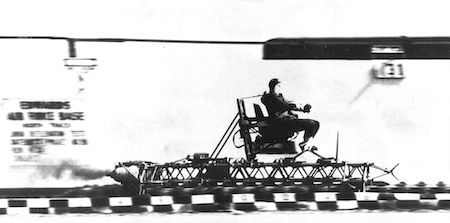

December 9, 2019
The Three Legged Pogo Stick (an abandoned patent)
If you’re an enthusiast of Pogo Sticks, you may have been wondering whatever happened to the 2002 US patent application from inventors John Hackworth, Kirk Hackworth and Mark Soderberg for their tripodic Pogo Device .
“
A more stable pogo stick device, which may or may not be steerable, employs multiple spring legs, at least one of which can have an alterable spring rate. To steer in a direction, the alterable spring rate is employed, whereupon the pogo will move in the direction of the softer spring. Further, a pogo stick with enhanced stability and safety is provided by employing multiple, vertical springing legs. A pogo with enhanced stability and widened foot platform provides the ability for a single rider to perform tricks and/or to allow multiple riders to jump together at the same time. “
For reasons that are not expanded upon in the official documentation, the application was : ABANDONED — FAILURE TO RESPOND TO AN OFFICE ACTION.
Bonus Assignment [optional] Determine, with explanations, the optimum number of legs for a pogo stick.
Research research by Martin Gardiner

December 8, 2019
Punch back from the anti-anti-alcohol forces
Having endured punch after punch, the anti-anti-alcohol forces rally once more against the anti-alcohol forces.
A press release from the University of Exeter proclaims:
Alcohol tolerance may have saved our ancestors from extinction
The ability to process alcohol may have saved humanity’s ancestors from extinction, a new book suggests.
About ten million years ago, our African ape ancestors were eating fallen fruits on the forest floor—many of which would have begun to ferment and become alcoholic.
At the time, ape populations were crashing in the face of competition with monkey species which were able to eat unripe fruit—which apes, like humans, struggle to digest.
What seems to have saved at least one line of apes, the book says, was a genetic adaptation that allowed them to process alcohol, meaning they could begin eating overripe fruits….
https://phys.org/news/2019-12-alcohol...

Marc Abrahams's Blog
- Marc Abrahams's profile
- 14 followers


